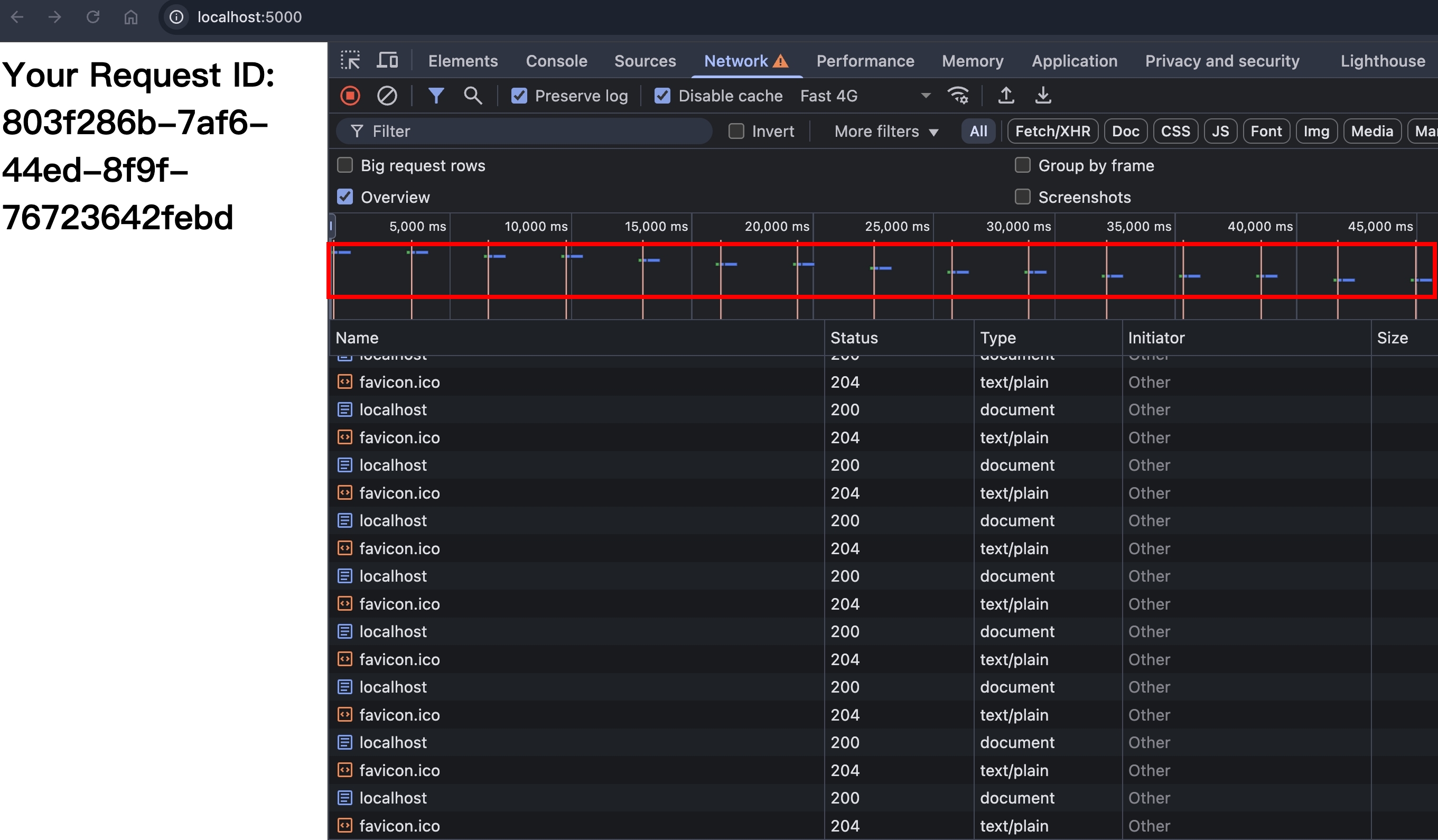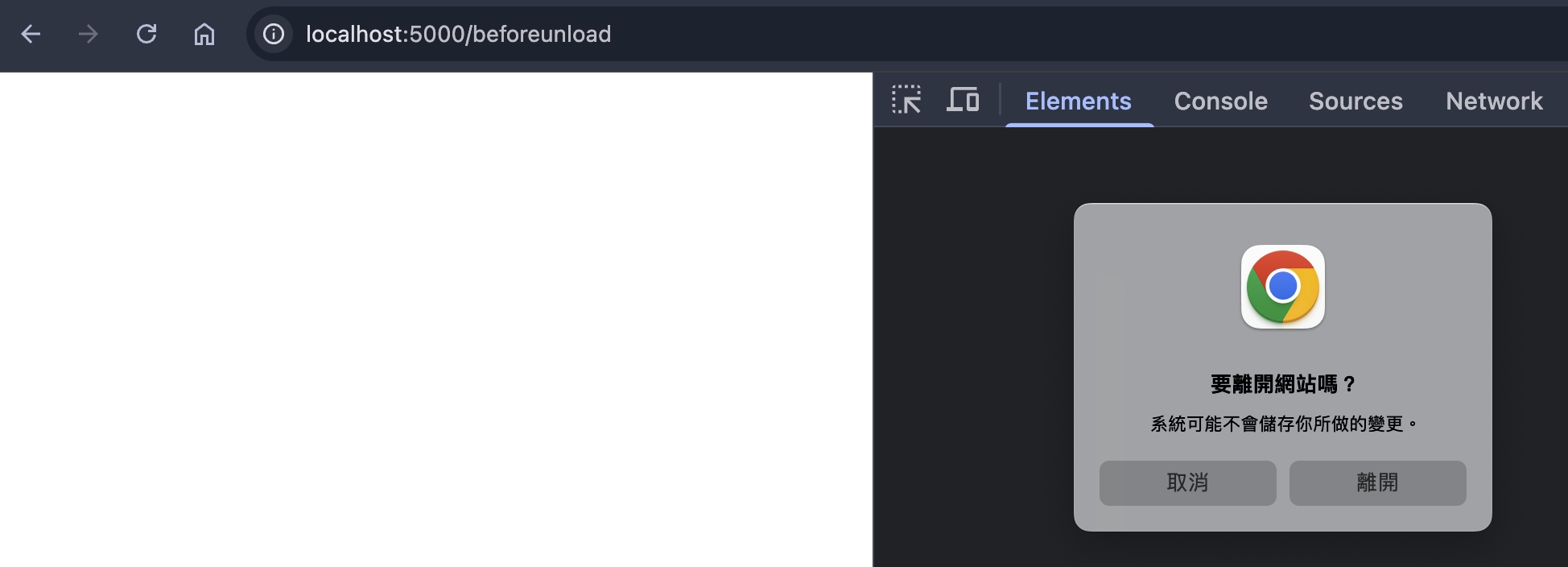Refresh
Refresh Response Header
Refresh 是一個 Response Header,將用戶在 N 秒後導向指定頁面,語法是
Refresh: 0
Refresh: 1, url=https://www.google.com
Refresh: 2; url=https://developer.mozilla.org
若不指定 url 的話,則代表原頁重整
Refresh without url
使用 NodeJS HTTP 模組實作
import httpServer from "../httpServer";
import { faviconListener } from "../listeners/faviconListener";
import { notFoundListener } from "../listeners/notFoundlistener";
httpServer.removeAllListeners("request");
httpServer.on("request", function requestListener(req, res) {
if (req.url === "/favicon.ico") return faviconListener(req, res);
if (req.url === "/") {
res.setHeader("Refresh", "3");
res.setHeader("Content-Type", "text/html");
res.end(`<h1>Your Request ID: ${crypto.randomUUID()}</h1>`);
return;
}
return notFoundListener(req, res);
});
瀏覽器打開 http://localhost:5000/ ,就可以看到每隔 3 秒刷新頁面的效果了

referrer
根據 MDN 文件的描述
Note: When a refresh redirects to a new page, the Referer header is included in the request for the new page (if permitted by the Referrer-Policy), and document.referrer is set to the referrer URL after navigating.
我們來測試看看,調整 NodeJS 的程式碼
if (req.url === "/") {
res.setHeader("Refresh", "0; url=https://localhost:5000/refreshed");
res.setHeader("Content-Type", "text/html");
res.end(`<h1>Your Request ID: ${crypto.randomUUID()}</h1>`);
return;
}
if (req.url == "/refreshed") {
res.setHeader("Content-Type", "text/html");
res.end(`
<html>
<head></head>
<body>
<div>req.headers.referrer: ${req.headers.referer}</div>
<div id="documentReferrer"></div>
<script>
document.getElementById("documentReferrer").innerText = "document.referrer: " + document.referrer
</script>
</body>
</html>
`);
return;
}
瀏覽器打開 http://localhost:5000/ ,可以看到 referrer 確實有帶到

Refresh with javascript protocol
如果 Server 端設定 Refresh: 0; url=javascript:alert(1),能夠執行程式碼嗎?我們試試看:
if (req.url === "/javascript-protocol") {
res.setHeader("Refresh", "0; url=javascript:alert(1)");
res.setHeader("Content-Type", "text/html");
res.end(`<h1>Your Request ID: ${crypto.randomUUID()}</h1>`);
return;
}
瀏覽器打開 http://localhost:5000/javascript-protocol
 結論是,不行~
結論是,不行~
HTTP redirect vs refresh
如果 HTTP redirect 跟 refresh 同時定義,會以誰為主呢?
// HTTP redirect vs refresh
if (req.url === "/http-redirect-vs-refresh") {
res.statusCode = 301;
res.setHeader("Location", "https://www.google.com");
res.setHeader(
"Refresh",
"0; url=https://developer.mozilla.org/zh-TW/docs/Web/HTTP/Reference/Status/301",
);
res.end();
return;
}
瀏覽器打開 http://localhost:5000/http-redirect-vs-refresh
 答案是 http 30x redirect 勝出!
答案是 http 30x redirect 勝出!
JavsScript redirect vs refresh
如果在 <script> 定義 redirect 跟 HTTP refresh,會以誰為主呢?
index.ts
// JavsScript redirect vs refresh
const javascriptRedirectHTML = readFileSync(
join(__dirname, "javascriptRedirect.html"),
);
if (req.url === "/javascript-redirect-vs-refresh") {
res.setHeader("Refresh", "0; url=https://developer.mozilla.org");
res.end(javascriptRedirectHTML);
return;
}
javascriptRedirect.html
<html>
<head></head>
<body>
<script>
location.assign("https://www.google.com");
</script>
</body>
</html>
瀏覽器打開 http://localhost:5000/javascript-redirect-vs-refresh
 答案是 JavaScript redirect 勝出!
答案是 JavaScript redirect 勝出!
meta refresh vs refresh
如果在 HTML 定義 meta 跟 HTTP refresh,會以誰為主呢?
metaRefresh.html
<html>
<head>
<meta http-equiv="refresh" content="0; url=https://www.google.com" />
</head>
<body>
<h1>meta refresh</h1>
</body>
</html>
index.ts
// meta refresh vs refresh
if (req.url === "/meta-refresh-vs-refresh") {
res.setHeader("Refresh", "0; url=https://developer.mozilla.org");
res.end(metaRefreshHTML);
return;
}
瀏覽器打開 http://localhost:5000/meta-refresh-vs-refresh
 答案是 meta refresh 勝出!
答案是 meta refresh 勝出!
那如果 meta 秒數比較慢,會以誰為主呢?
metaRefresh.html
<html>
<head>
<meta http-equiv="refresh" content="1; url=https://www.google.com" />
</head>
<body>
<h1>meta refresh</h1>
</body>
</html>
瀏覽器打開 http://localhost:5000/meta-refresh-vs-refresh
 答案是 refresh 勝出!
答案是 refresh 勝出!
Redirection order of precedence
上面測試了很多情境,根據 MDN 文件的描述
Note: Even though it's present in the HTTP response, the Refresh header is still handled by the HTML loading machinery and happens after HTTP or JavaScript redirects.
總結一下 redirect 的優先順序:
- HTTP Redirect(30x status code 搭配 Location)
- JavaScript Redirect(例如:
location.assign("URL")) - HTML Meta Refresh(例如:
<meta http-equiv="refresh" content="3; url=https://www.google.com">) - HTTP Refresh
beforeunload and refresh
既然 HTTP Refresh 是透過 HTML 的機制,那 beforeunload 應該也會觸發?
beforeunload.html
<html>
<head></head>
<body>
<script>
addEventListener("beforeunload", (e) => {
e.preventDefault();
e.returnValue = "123";
});
</script>
</body>
</html>
index.ts
// beforeunload
if (req.url === "/beforeunload") {
res.setHeader("Refresh", "3; url=https://www.google.com");
res.end(beforeunloadHTML);
return;
}
瀏覽器打開 http://localhost:5000/beforeunload ,並且點擊螢幕製造 user interaction(原因可參考 MDN 文件)
In other words, the browser will only show the dialog box if the frame or any embedded frame receives a user gesture or user interaction.
 答案是會觸發 beforeunload!
答案是會觸發 beforeunload!
小結
本篇文章,帶大家了解 HTTP Refresh 的機制,並且也跟 HTTP Redirect 還有 JavaScript Redirect 去做比較,希望大家收穫滿滿。